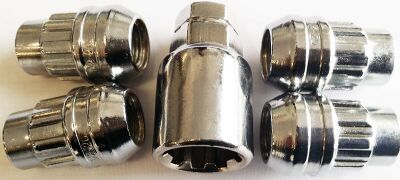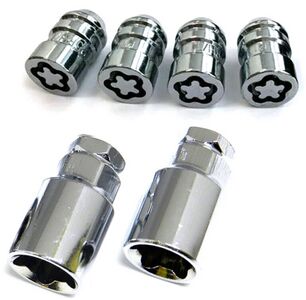![]() The content of any article might be expanded / improved in the future - revisit it sometimes.
The content of any article might be expanded / improved in the future - revisit it sometimes.
![]() Seen a mistake? Know something that isn't written? Edit and change this article yourself!
Seen a mistake? Know something that isn't written? Edit and change this article yourself!
![]() Some images in the article (if present) can be enlarged by clicking on them.
Some images in the article (if present) can be enlarged by clicking on them.
Contents
Introduction
- Other people's automotive wheels and tyres are on many thieves' list of desirable items to take possession of.
- Another case when someone may want to steal a wheel and/or tyre from your car is when their wheel or tyre gets damaged.
- Even Jimny wheels get stolen, usually for the second motive described above.
- Therefore, a suitable anti-theft protection for the wheels is highly recommended.
- That protection means to have at least one locking / security (anti-theft) wheel nut installed per wheel, including the spare wheel.
- As a matter of fact, the spare wheel might be the first target of a thief, as it is by far easier and quicker to remove from the car than any of the road wheels.
- The problem is that most locking / security wheel nut products on the market come in sets of four.
- Five-nut sets are uncommon.
- Therefore, if you obtain a four-nut set instead of a five-nut set, it might be more logical to install one locking nut onto the spare wheel at the cost of omitting one road wheel.
- Forum user Bosanek made a mistake of omitting the spare wheel instead with his four-nut set (in order to protect all four road wheels), and learned the hard way later on why that was a mistake ...
Wheel nut specifications
- Not all wheel nuts are compatible with every vehicle.
- All Jimny generations require wheel nuts (not bolts!) with specifications M12 x 1.25.
- The 1st number represents the wheel stud bolt thickness in millimeters.
- The 2nd number represents how coarse the bolt / nut thread is.
- The wheel nut should be tapered at 60 degrees on its end which goes towards the wheel hub.
- The height / length of the wheel nut should be at least 30 mm.
- The un/locking tool should be compatible with 19 mm hex socket wrenches.
- Many of them are, with some being dual 17 mm / 19 mm compatible.
Types of locking wheel nuts
Regarding their security design, there are generally three types of locking wheel nuts.
- Design A - the grooves on the nut (for the unlocking tool to bite on during un/locking) are positioned on the outside of the nut.
- This is the most common and generally the cheapest design.
- The major disadvantage of this design is that a skilled thief may be able to undo the nut using forcible methods (heavy duty pliers etc.) because the outside grooves on the nut allow them to get a very good grip on the nut.
- Design B - the grooves on the nut (for the unlocking tool to bite on during un/locking) are positioned on the inside of the nut. The outside of the nut is a plain barrel.
- This type of nut is more difficult to forcibly undo with pliers etc., as the "plain barrel" outside shape of the nut does not allow a very good grip to be obtained.
- Design C - the grooves on the nut (for the unlocking tool to bite on during un/locking) are positioned on the inside of the nut (as in design B). Additionally, the outside surface of the nut is a freely rotatable ring.
- This is typically the most expensive design because of the freely rotatable outside ring.
- This type of nut is exceptionally difficult if not impossible to remove using forcible methods.
- The only disadvantage of this design is if you lose or damage the un/locking tool.
- In that case, it will be quite difficult and/or expensive to remove the locking nuts even at specialist workshops where they typically offer forcible locking nut removal services.
- However, if you buy brand name locking wheel nuts, you should be able to order replacement matching un/locking tool from the manufacturer if you still have the original key code which you had received with your locking nut set.
- Examples of locking wheel nut designs
Some nuts come with hex-alike caps, so that they on a first glance appear like regular plain wheel nuts.
Some nuts are closed-ended and some are open-ended.
- This means if the end of the nut toward the outside world is open (so that you can see the stud bolt through it when bolted on) or if it is closed.
- Closed ended is better to prevent crud / mud build up in the nut.
Some nuts are "tuner type":
- Such nuts are narrower than regular nuts and are usually of design B.
- They are meant for aftermarket wheels which have narrower holes for the wheel studs than OEM wheels.
- A regular nut could not be used with such wheels, as there would be no space for the wrench or the un/locking tool to fit around the nut.
- Internet literature generally suggests NOT to use tuner type nuts with OEM wheels.
Compatible locking wheel nut products
OEM
Suzuki sells (or used to sell) the following locking wheel nut models for Jimnys 3:
- 00800-63242-000
- Four-nut set.
- Design A.
- An older model, offered for example in Suzuki's catalogue 99F00-20M21-001 from year 2006.
- 99000-990Y7-013
- Four-nut set.
- Appears to be design B.
- 990E0-59J49-000
- Four-nut set.
- Appears to be design A.
- Suzuki's market name of this product is "Sicurit".
- 990E0-59J47-000
- Four-nut set.
- Design C - the premium model.
- It is actually made in Italy by Farad, model name 1-RA/E STAR LOCK 1CH.
- Suzuki's market name of this product is "Sicustar".
- This product was used by forum user Bosanek and it is very high quality.
- It's a pity that it does not have a 5th nut.
Aftermarket
Suitable known aftermarket products on the British market (in alphabetical order):
- Bimecc UM215
- Four-nut set.
- Design A.
- The suitability of this product for Jimnys is not confirmed.
- There also exists model UMO215.
- It is an open ended edition of UM215.
- Evo5 (also known as Evo MK5) model 479/5
- Four-nut set.
- Design C.
- Allegedly also a five-nut set exists, but manufacturer's web site contains very little data about anything.
- Febi Bilstein 27058.
- Four-nut set.
- Design A.
- Identical product as SWAG 82 92 7058 (see below).
- Gen2 GLNBTC341921C
- Four-nut set.
- Design A.
- There also exists a black edition of the same nuts - Gen2 GLNBTB341921C.
- Gen2 GLNPBTC341921C
- Four-nut set.
- Appears to be design B.
- Gen2 GLNPBTB341921C
- Four-nut set.
- Design either B or C - not sure.
- Note: Black color.
- Grayston LN103 and LN103/5
- Model LN103 is a four-nut set.
- Model LN103/5 is a five-nut set!
- Appears to be design B.
- Heyner StilBull 650
- Precise model name: 856670(DGI)
- Model 856670(R) should also be compatible.
- Four-nut set.
- Appears to be design B.
- Precise model name: 856670(DGI)
- McGard 24152
- Four-nut set.
- Appears to be design B, possibly C.
- McGard 24154
- Four-nut set.
- Appears to be design B, possibly C.
- McGard 24552
- Five-nut set!
- Appears to be design B, possibly C.
- Specification says that its un/locking tool is 3/4" hex size - that is 19 mm metric.
- SWAG 82 92 7058.
- Four-nut set.
- Design A.
- Identical product as Febi Bilstein 27058 (see above).
- Trilock
- Four-nut set.
- Design C.
- Manufacturer's web site contains very little data about anything.
- However, their locking nut sets can be found online for Jimnys, but have no part numbers to differentiate them.
- Wolfrace AC-005
- Four-nut set.
- Appears to be design A.
- The suitability of this product for Jimnys is not confirmed.
![]() The above list is incomplete.
The above list is incomplete.
Add other compatible manufacturers and models if you find them.
In theory, any wheel nuts which conform to the specifications from this article will suit any Jimny generation.
Page last edited on 15/02/2023 by user Bosanek



